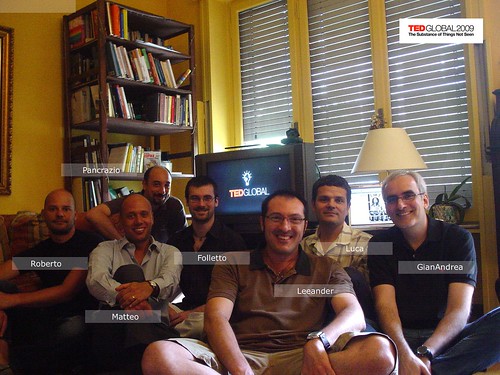Last week I had the chance (thanks to my friend and partner in crime Leeander) to enjoy one of the best (dare I say THE best) conferences in the world: the TED Conference, in its European dress (who’s lead by another friend: Bruno Giussani). (we’ve been featured on TED’s blog here)

The crew at leeander's - shot by Leeander
The 3 days where streamed at Leeander’s home (which I renamed Leeander Conference Apartment) via a high-quality zero-plugin live video feed which was displayed on the home TV (a steampunk cathodic flat TV ![]() ); both the sound and the video quality were suberp and we had zero problem with the image compression (at least until the screen was plenty with white and the video compressor just “messed everything up” to say it with Roberto Ostinelli‘s own words).
); both the sound and the video quality were suberp and we had zero problem with the image compression (at least until the screen was plenty with white and the video compressor just “messed everything up” to say it with Roberto Ostinelli‘s own words).
I’ve been there just for an hour: enough to catch something of the whole TED experience and learn about an autonomously moving sphere that locates noises and deletes them and the story of Lewis Pugh, arctic swimmer and great story teller.
But a couple of things were absolutely noticeable in the conference itself (and I write them down for next year Frontiers of Interaction organization).
TED is more a theatre performance than your usual conference:
- it’s held (at least, its 2009 European version) in a theatre;
- the speakers are on the stage (which – by the way – it’s really small);
- the stage itself is perfectly dressed up and there’s no view of the tech aspects of the conference (monitors ot whatsoever) from the audience point of view;
- all the lights (but those on the stage) are down.
TED is more a TV show than a theatre performance:
- It’s stage dimensions, lights and dressing are perfect to be reproduced on video;
- Great video direction (but we have something really cool at Frontiers too – thanks to Biccio and his crew);
- It’s a 700 people/year live conference; but it’s 5 most viewed YouTube videos totalized more than 4 millions views in less than 2 years.
Just a last thing to remember: all the speakers used a mostly invisible, cheeck-mounted microfone, which leave them completely free to move and emotionally interact with the audience (just as Gianfranco suggested).
Question: it seems to me that there’re 3 different monitors (invisible from the audience side) on the stage; I thought they contained time counter + slides but looking at the video it seems they have something different. Any suggestion?
